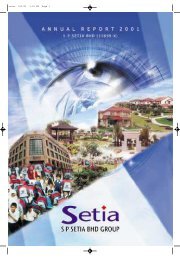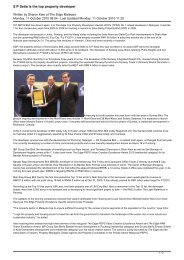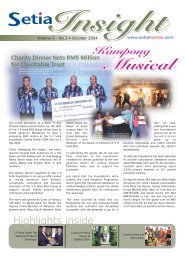Change - S P Setia Berhad
Change - S P Setia Berhad
Change - S P Setia Berhad
Create successful ePaper yourself
Turn your PDF publications into a flip-book with our unique Google optimized e-Paper software.
96<br />
Annual report 2008<br />
NOTES TO THE FINANCIAL STATEMENTS<br />
FOR THE YEAR ENDED 31 OCTOBER 2008<br />
2. FINANCIAL RISK MANAGEMENT OBJECTIVES AND POLICIES<br />
The Group’s activities are exposed to a variety of financial risks, including interest rate risk, credit risk, market risk, liquidity and<br />
cash flow risks. The Group’s overall financial risk management objective is to minimise potential adverse effects on the financial<br />
performance of the Group.<br />
Financial risk management is carried out through risk review, internal control systems and adherence to Group financial risk<br />
management policies. The Board regularly reviews these risks and approves the policies covering the management of these risks.<br />
The Group does not trade in derivative instruments.<br />
(a)<br />
Interest rate risk<br />
The Group is exposed to interest rate risk which is the risk that a financial instrument’s value will fluctuate as a result of<br />
changes in market interest rates. Exposure to interest rate risk relates primarily to the Group’s deposits and interest-bearing<br />
borrowings.<br />
Surplus funds are placed with licensed financial institutions to earn interest income based on prevailing market rates. The<br />
Group manages its interest rate risks by placing such funds on short tenures of 12 months or less.<br />
The Group’s policy is to borrow principally on a floating rate basis but to retain a proportion of fixed rate debt. The objective<br />
of a mix of fixed and floating rate borrowings is to reduce the impact of a rise in interest rates and to enable savings to<br />
be enjoyed if interest rates fall. The Group does not generally hedge interest rate risks. The Group has a policy to ensure<br />
that interest rates obtained are competitive.<br />
(b)<br />
Credit risk<br />
Credit risk arises from the possibility that a counter party may be unable to meet the terms of a contract in which the<br />
Group has a gain position.<br />
The Group minimises and monitors its credit risk by dealing with credit worthy counter-parties and applying credit approval<br />
controls for material contracts. If necessary, the Group may obtain collaterals from counter-parties as a means of mitigating<br />
losses in the event of default.<br />
In respect of trade receivables arising from the sale of development properties, the Group mitigates its credit risk by<br />
maintaining its name as the registered owner of the development properties until full settlement by the purchaser of the selffinanced<br />
portion of the purchase consideration and upon undertaking of end-financing by the purchaser’s end-financier.<br />
(c)<br />
Market risk<br />
The Group’s principal exposure to market risk arises from changes in value caused by movements in market prices of its<br />
quoted investments. The risk of loss is minimised via thorough analyses before investing and continuous monitoring of the<br />
performance of the investments. The Group optimises returns by disposing of investments after thorough analyses.<br />
Common to all business, the overall performance of the Group’s investments is also driven externally by global and domestic<br />
economies that are largely unpredictable and uncontrollable.<br />
(d)<br />
Liquidity and cash flow risks<br />
The Group seeks to ensure all business units maintain optimum levels of liquidity at all times, sufficient for their operating,<br />
investing and financing activities.<br />
Therefore, the policy seeks to ensure that each business unit, through efficient working capital management (i.e. inventory,<br />
accounts receivable and accounts payable management), must be able to convert its current assets into cash to meet all<br />
demands for payment as and when they fall due.<br />
Owing to the nature of its businesses, the Group always maintain sufficient credit lines available to meet its liquidity<br />
requirements while ensuring an effective working capital management within the Group.

















